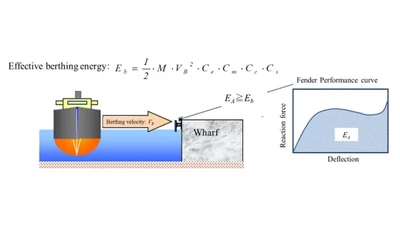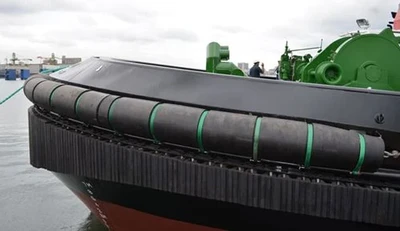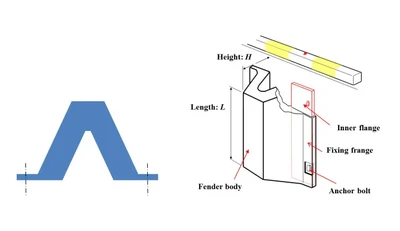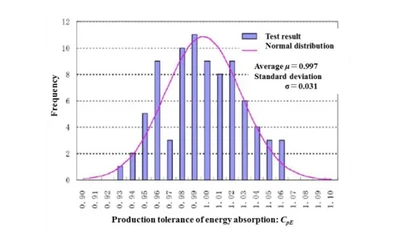1 GD type rubber
l Smaller bottom width size, especially suitable for framed docks
l High energy absorption and high reaction force.
l High installation strength and long service life.
2. Super Drum SC
l Increased energy absorption/reaction force value
The E/R.H value of SC super drum type rubber fender is about 15% higher than that of ordinary drum type rubber fender, the E/R.H value of ordinary drum type rubber fender is generally 0.375~0.385, while the E/R.H value of SC super drum type rubber fender is generally 0.43~0.44.
l More reasonable structure
SC super drum type rubber fender has a more reasonable structure compared with common rubber fender, the fender barrel and flange connection adopts a rounded excess, reducing the stress concentration in the root of the fender when compressing and deforming, the fender is more reasonably stressed, and the compression volume of the fender is increased from 47.5% to 52.5%.
l SC super drum type rubber fender has the same installation bolt distance and bolt holes as the common type rubber fender.
l Low influence of inclined berthing.
3 Cone type fender ZC
TD-AA conical rubber fender is the third generation of drum type rubber fender, it adopts the new structure design of conical rubber body and front steel frame, so that the design compression deformation of the fender is increased from 52.5% to 70% without increasing the reaction force, it becomes one of the rubber fenders today, its appearance can make the design of wharf structure lighter and reduce the cost of wharf project, it is an ideal substitute for super drum type rubber fender It is an ideal alternative to the super drum fender.
It has been ten years since the introduction of cone rubber fender, the design of cone rubber fender has become the new trend of today's quay design, representing the new level of quay fender design.
l Compared with super rubber fenders of the same size, the energy absorption is nearly doubled.
l When the product reaction force and energy absorption are similar, the small TD-AA cone-shaped rubber fender can replace the larger TD-A super drum rubber fender, i.e. TD-AA800H cone-shaped fender can replace TD-A1000H fender and reduce the cost of the quay project.
4 D type rubber fender
l The reaction force and energy absorption are suitable
l The width of the bottom is moderate, which makes it suitable for frame type quay.
l Light weight, easy to install and maintain.
5 Cylindrical (Y) fender
l Low reaction force, small surface pressure, reasonable energy absorption
l Strong adaptability to the horizontal and vertical shaking of ships at berth
l Wide range of application, also can be used as ship anti-collision device
l Easy to install and maintain
6 W-type rubber fender
l Large top area of fender, small contact surface pressure.
l High energy absorption and low reaction force, suitable for docks of over 10,000 tons.
l Adjustable span between two support arms, compression deformation up to 52.5%;.
l The outer surface of the anti-scouring plate is ultra-high polymer polyethylene plate or nylon, which has a small coefficient of friction.
l Can be installed vertically or horizontally, without the need for supporting anchor chains.
7 V-shaped rubber fender
l Moderate reaction force, high energy absorption
l Firm installation and easy disassembly
l Suitable for medium-sized docks
8 Wraparound fenders
9 Rotating fenders
Rotating rubber fenders use the rotation of rollers and compression deformation (rubber) to absorb the energy of ship impact. When a ship berths or moves, the rotating fender can adapt to the movement of the ship and produce rotation, thus ensuring the safety of the quay and the ship. Rotating fenders are suitable for use in shipyards, dockyards, ro-ro quays, quay corners and on occasions where the direction of ship movement and berthing speed are required.
Features.
l The fender (rollers) rotates on three axes, which can and reduce the running speed of the ship, which is conducive to the safe berthing of the ship.
l The compression deformation can reach 40%, which is more than double the energy absorption of traditional rotating fenders.
l Since the rotating fender can adapt to the movement of the hull and rotate, the hull and fender do not produce sliding friction, so it is not easy to damage the hull paint.
10 Rubber gangway
l Both rubber fender and ladder function, more durable than steel ladder
l No need to hide the ladder in a concave position, the same installation as rubber fenders
l not afraid of collision, no rust, ladder column with bendability
l Easy to install and maintain
 The role of rubber fenders part 1December 16, 2024A rubber fender is a shock absorber installed on a wharf to absorb the berthing energy of a vessel. Timber and old tires were used as shock absorbers until the first rubber fenders were developed in t...view
The role of rubber fenders part 1December 16, 2024A rubber fender is a shock absorber installed on a wharf to absorb the berthing energy of a vessel. Timber and old tires were used as shock absorbers until the first rubber fenders were developed in t...view Five types of popular tug boat fendersDecember 16, 2024Tug boat fenders are high abrasion resistance rubber fenders used to protect the vessel and the other surface during contact. Boat fenders are also known as boat bumpers, rubber fenders and marine fen...view
Five types of popular tug boat fendersDecember 16, 2024Tug boat fenders are high abrasion resistance rubber fenders used to protect the vessel and the other surface during contact. Boat fenders are also known as boat bumpers, rubber fenders and marine fen...view Rubber fenders without fender panelsDecember 16, 2024V-type rubber fenders are considered as rubber fenders without fender panels. A V-type rubber fender has a V-shaped cross section with steel plates embedded in the fixing flange portion for installati...view
Rubber fenders without fender panelsDecember 16, 2024V-type rubber fenders are considered as rubber fenders without fender panels. A V-type rubber fender has a V-shaped cross section with steel plates embedded in the fixing flange portion for installati...view Performance of rubber fendersDecember 16, 2024In the design process, the performance of rubber fenders is considered in terms of deflection-reaction force characteristics in compression and the energy absorption calculated from these characterist...view
Performance of rubber fendersDecember 16, 2024In the design process, the performance of rubber fenders is considered in terms of deflection-reaction force characteristics in compression and the energy absorption calculated from these characterist...view